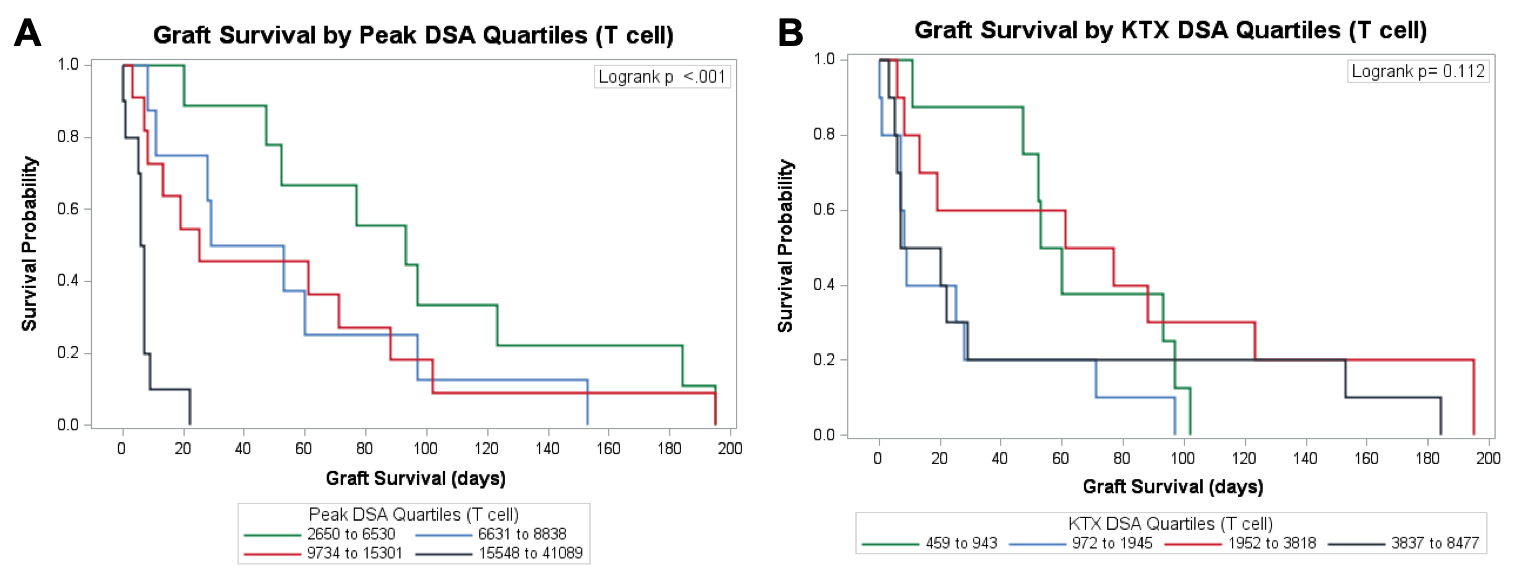Peak DSA Levels Pre-Transplant but Not at Transplant Predict Graft Survival
1Duke University School of Medicine, Durham, NC, 2Duke Biostatistics, Epidemiology, and Research Design Core, Duke University, Durham, NC, 3Department of Surgery, Duke University Medical Center, Durham, NC, 4Department of Pathology, Emory University Hospital, Atlanta, GA
Meeting: 2020 American Transplant Congress
Abstract number: 574
Keywords: Antibodies, Graft failure, Kidney transplantation, Primates
Session Information
Session Name: Kidney Immunosuppression: Desensitization
Session Type: Oral Abstract Session
Date: Saturday, May 30, 2020
Session Time: 3:15pm-4:45pm
 Presentation Time: 4:27pm-4:39pm
Presentation Time: 4:27pm-4:39pm
Location: Virtual
*Purpose: Immunization to major histocompatibility complex (MHC) antigens is a barrier in kidney transplantation (KTx) due to higher risk of antibody-mediated rejection (AMR) and graft loss. Desensitization regimens aim to reduce donor-specific antibodies (DSA) prior to KTx. We examined correlations between pre-transplant DSA and KTx outcomes in nonhuman primates.
*Methods: Maximally MHC mismatched rhesus macaques (n=41) were sensitized with 2 sequential skin transplants. Primates were desensitized with experimental protocols including carfilzomib (CFZ), CFZ+tocilizumab, CFZ+daratumumab+plerixafor, CFZ+tabalumab, CFZ+anti-CD28dAb, and CFZ+belatacept. Serum DSA was measured by flow crossmatch (FXM). We defined peak DSA as the highest level measured after the second skin transplant and calculated the change from peak DSA to DSA at KTx. We used the log-rank test to compare graft survival among peak DSA quartiles (Kaplan-Meier curves). We used Spearman correlations to characterize the relationship between DSA and both graft survival and AMR severity (clustered Banff, g+ptc+C4d).
*Results: Graft survival varied significantly among peak DSA quartiles (log-rank p<0.001, Figure 1A). Greater drop in DSA levels prior to KTx correlated with shorter graft survival in both T cell and B cell FXM (rs = -0.59, p<0.001 and rs = -0.48, p=0.002). Peak DSA levels and change in DSA from peak to time of KTx negatively correlated with AMR severity. Finally, DSA levels at KTx did not significantly correlate with graft survival or AMR severity (rs = -0.29, p=0.13; log-rank p=0.112, Figure 1B).
*Conclusions: DSA levels negatively correlated with graft survival and AMR severity. Under pharmacologic influence, the magnitude and change in DSA levels between sensitization and KTx may be a better prognostic tool than DSA levels at KTx. Given differences in regimens and timelines in this cohort, these findings deserve further investigation.
To cite this abstract in AMA style:
Choi AY, Olaso D, Jr TRisoli, Kuchibhatla M, Fitch Z, Schmitz R, Schroder PM, Jackson A, Manook M, Yoon J, Farris AB, Kwun J, Knechtle SJ. Peak DSA Levels Pre-Transplant but Not at Transplant Predict Graft Survival [abstract]. Am J Transplant. 2020; 20 (suppl 3). https://atcmeetingabstracts.com/abstract/peak-dsa-levels-pre-transplant-but-not-at-transplant-predict-graft-survival/. Accessed December 24, 2025.« Back to 2020 American Transplant Congress

